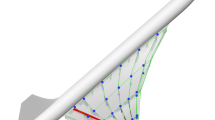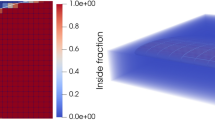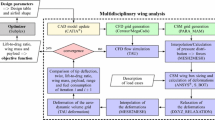Abstract
An optimization technique was used to generate a wing-in-ground-effect (WIG) configuration which can achieve the maximum lift and satisfy the height stability criteria within the design constraints. For the analysis of the aerodynamic coefficients, the vortex lattice method (VLM) was applied with the inviscid and potential flow approximations. The sequential quadratic programming (SQP) method, which is a nonlinear optimization method, was employed as an optimization tool. The lift and moment coefficients, including the stability analysis computed by VLM, were compared with the experimental results of a medium-sized WIG, and a good correlation was found between them. In addition, the optimization tool was validated by finding the optimal position of the side wing attached on the WIG craft. Then, various optimum examples are shown, with generation of the wing section, the determination of the planform configuration, the aspect ratio, and the position of the tail wing within the design constraints. It was shown that the present optimization tool can be used effectively for the optimal design of a WIG craft.










Similar content being viewed by others
References
Nuhait AO, Mook DT (1989) Numerical simulation of wings in steady and unsteady ground effects. J Aircr 26:1081–1089
Mizutani N, Suzuki K (1993) Numerical analysis of a 3-D WIG advancing over a still water surface (in Japanese). J Soc Nav Archit Jpn 174:35–46
Park IR, Chun HH (1995) A study on the free surface effect of 2-D airfoils (in Korean). J Ocean Eng Technol 9:75–82
Park IR, Chun HH (1995) Numerical simulation of unsteady performance for 2-D surface-effect airfoils (in Korean). J Ocean Eng Technol 9:71–74
Park IR, Chun HH (1998) Analysis of steady and unsteady performance for a 3-D surface-effect wing (in Korean). J Soc Nav Archit Korea 35:14–25
Fink PM, Lastinger LJ (1961) Aerodynamics characteristics of low-aspect-ratio wings in close proximity to the ground. NASA TN D-926, Hampton
Carter AW (1961) Effect of ground proximity on the aerodynamic characteristics of aspect-ratio-1 airfoils with and without endplates. NASA TN D-970, Hampton
Chun HH (1996) Experimental studies on wing-in-ground-effect for three different wing section configurations. Report NAOE-R-9604, Department of NAOE, Pusan National University (in Korean)
Jung KH, Chun HH, Kim HJ (2008) Experimental investigation of wing-in-ground effect with a NACA6409 section. J Marine Sci Technol. doi:10.1007/s00773-008-0015-4
Kim SK, Suh SB, Lee DH, Kim KE (1997) Wind tunnel test study on the wings of a WIG ship (in Korean). J Soc Nav Archit Korea 34:60–67
Ahmed NA, Goonaratne J (2002) Lift augmentation of a low-aspect-ratio thick wing in ground effect. J Aircr 39:381–384
Shin MS, Yang SI, Joo YR, Kim SK, Bae YS, Kim JH, Chun HH (1997) Wind tunnel test results for eight- and twenty-passenger class WIG effect ships. In: Proceedings of the international conference on FAST sea transportation, Sydney, pp 565–570
Chun HH, Chang JH, Paik KJ, Chang SI (1997) Preliminary design of a 20-passenger PARWIG craft and construction of a 1/10 scale radio-controlled model. In: Proceedings of the international conference on FAST sea transportation, Sydney, pp 513–520
Kong CK, Park H, Yoon J, Kang K (2007) Conceptual design on carbon-epoxy wing of a small-scale WIG vehicle. Key Eng Mater 334:353–356
Chun HH, Chang CH (2002) Longitudinal stability and dynamic motions of a small passenger WIG craft. Ocean Eng 29:1145–1162
Kumar PE (1969) On the stability of the ‘ground effect wing’ vehicle. Ph.D. Thesis, The University of Southampton
Irodov RD (1970) Criteria of longitudinal stability of Ekranoplan. Ucheniye Zapiski TSAGI 1:63–74
Staufenbiel RW (1987) On the design of stable ram wing vehicles. In: Proceedings of RAM wing in ground effect craft. The Royal Aeronautical Society, London, pp 110–136
Hall IA (1994) An investigation into the flight dynamics of wing-in-ground-effect aircraft operating in aerodynamic flight. M. Sc Thesis, Cranfield University
Delhaye H (1997) An investigation into the longitudinal stability of wing-in-ground-effect vehicles. MSc Thesis, Cranfield University
Gera J (1995) Stability and control of wing-in-ground-effect vehicles, or wing ships. AIAA 95-0339, Reston
Kornev N, Matveev K (2003) Complex numerical modeling of dynamics and crashes of wing-in-ground vehicles. 41st Aerospace Sciences Meeting and Exhibit, 6–9 January 2003, Reno. AIAA 2003–0600
De Divitiis N (2005) Performance and stability of a winged vehicle in ground effect. J Aircr 42:148–157
Suzuki K, Matsumoto S, Shingo S, Wake C (1998) Shape optimization of two-dimensional WIG based on potential theory (in Japanese). J Kansai Soc 229:1–11
Rozhdestvensky KV, Savinov GV (1998) Optimal design of wing sections in extreme ground effect. In: Proceedings of poster session for 22nd symposium on naval hydrodynamics. Washington, DC, pp 10–19
Kim HJ, Chun HH (1999) Design of 2-dimensional WIG section by a nonlinear optimization method (in Korean). J Soc Nav Archit Korea 36:50–59
Chang CH (1999) Design and performance analysis of a medium-sized wing-in-ground-effect craft. M. Sc Thesis, Pusan National University (in Korean)
Jung KH, Jang JH, Chun HH (1998) A study on the performance of the wing in ground effect by a vortex lattice method (in Korean). J Ocean Eng Technol 12:87–96
Chun HH, Chung KH, Shin MS (1997) Performance analysis of wing-in-ground-effect craft. In: Proceedings of RINA WIGs Conference, London, Paper No. 14
Vanderplaats GN (1984) Numerical optimization techniques for engineering design. McGraw-Hill, New York
Acknowledgments
This work was supported by the Advanced Shipbuilding Engineering Research Center (ASERC) and by a grant from the Korea Science and Engineering Foundation (KOSEF).
Author information
Authors and Affiliations
Corresponding author
About this article
Cite this article
Kim, H.J., Chun, H.H. & Jung, K.H. Aeronumeric optimal design of a wing-in-ground-effect craft. J Mar Sci Technol 14, 39–50 (2009). https://doi.org/10.1007/s00773-008-0020-7
Received:
Accepted:
Published:
Issue Date:
DOI: https://doi.org/10.1007/s00773-008-0020-7




